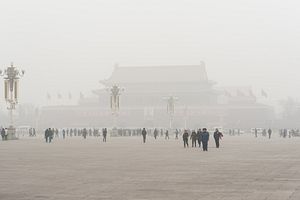Amid heavy smog in China’s capital, the Beijing government issued its first-ever “red alert” for air pollution, Xinhua reported on Monday. The alert, which will last from 7 am on Tuesday to 12 pm on Thursday, means schools and outdoor construction sites will be shut down, cars will be banned from the roads on alternate days, and factories will be forced to slow down or stop production altogether.
Beijing’s four-tiered, color-coded alert system for air pollution was created in October 2013. This week marks the first time Beijing has ever issued a red alert warning, despite intense periods of pollution in the past. Environmental activists have criticized the government for being unwilling to go beyond the second-highest level, an orange alert, despite pollution meeting the level of a red alert.
Last week, with the city enveloped in smog, Greenpeace East Asia climate campaigner Zhang Kai called the alert system into question. “[A] Red Alert should be put into place if AQI levels of 200 or more are predicted to last for three days or longer,” Zhang wrote. “But despite Beijing’s pollution levels exceeding this threshold consistently over the past two years, a Red Alert has never been issued for the city.”
“But as PM2.5 levels soar to over 900 mg/m3 in parts of the city; if pollution that far outstrips WHO recommended safe levels isn’t enough to elicit the highest level of response, then what is?” Zhang asked. The World Health Organization guidelines call for 24-hour exposure to PM2.5 pollution to be limited to 25 micrograms/cubic meter or less.
Angst in Beijing over the high levels of smog is compounded by Beijing’s demonstrated ability to bring back blue skies when necessary – witness the “APEC Blue” that came with China’s hosting of the Asia Pacific Economic Cooperation forum in November 2014, and the “Parade Blue” that accompanied China’s celebration of the 70th anniversary of the end of World War II in September 2015. Those events demonstrated how effective strict government controls can be in eliminating the smog over the city — when the government wants to enact those restrictions (which seems to be limited to when the city is hosting major international events).
Bloomberg noted last week that the heavy smog had turned many netizens against Beijing’s mayor Wang Anshun. But it will take more than action from the Beijing municipal government to stem the problem – neighboring Hebei province, with a heavy concentration of coal and steel plants, is a major contributor to the capital’s air pollution problem. Just this summer, the local governments of Beijing, Hebei, and Tianjin got together to begin work on a joint plan for controlled air pollution, but it will take time to see results.
Despite the red alert in Beijing this week, data suggests that air pollution in China – and especially Beijing – is actually slowly improving. According to a Greenpeace report from October 2015, “China’s pollution levels are dropping at an average rate of 12 percent a year following emergency government action.” Beijing actually did slightly better than the national average, with air pollution levels down 15 percent from 2014.
But despite that progress, the country still has a long way to go. Nearly 80 percent of the cities monitored by Greenpeace have “dangerously” high air pollution levels, the report noted.
China’s government recently claimed a victory in the “war on pollution,” with Environmental Protection Minister Chen Jining reporting that China had achieved its pollution reduction goals as laid out on the 12th Five Year Plan (reducing sulfur dioxide emissions by 8 percent and ammonia nitrogen and nitrogen oxide emissions by 10 percent compared to 2010 levels). Chen also admitted that China is far from solving the problem, however, saying that the country won’t see substantial improvement in its environment unless pollution is reduced by another 30 to 50 percent.
Meanwhile, Caixin said that China’s emissions of sulfur dioxide were nearly 50 percent larger than the figures reported by the government. Luo Jianhua, secretary-general of the China Environment Chamber of Commerce, put SO2 emissions at 30 million tons rather than the government-reported 19 million — a discrepancy caused by the government not counting “SO2 emissions from facilities other than those generating electricity, such as steel and cement factories, and private boilers heating homes in winter,” according to Caixin.
The SO2 discrepancy recalls China’s need to drastically revise its estimates for the amount of coal burned over the past decade after underreporting those figures as well. Monitoring environmental hazards continues to be a challenge for China, not to mention actually enforcing its rules and regulations. As China looks to move to a nation-wide emissions trading scheme by 2017, the government will need to step up its ability to monitor and regulate polluting industries.
In the meantime, cities like Beijing will suffer through the now-annual “airpocalypse” each winter.

































